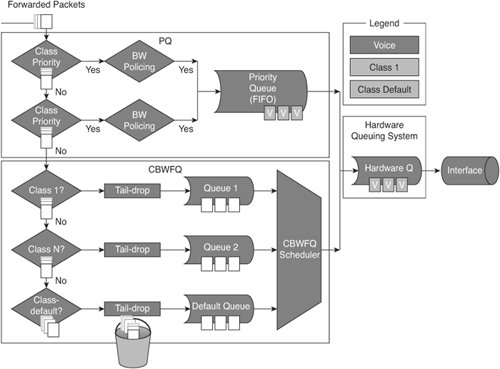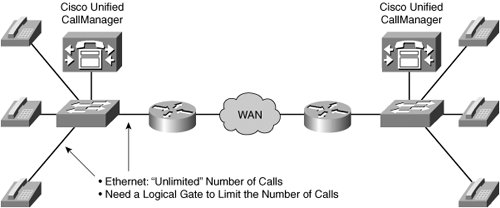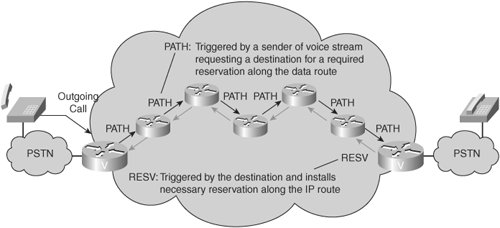Implementing Call Admission Control
| To prevent oversubscription of VoIP networks, the number of voice calls allowed on the network must be limited. This section describes the configuration parameters for implementing CAC, which can prevent oversubscription of WAN resources. Effects of Bandwidth OversubscriptionQoS tools such as queuing ensure that voice traffic receives priority over data traffic. However, if a network link is oversubscribed with too much voice traffic, data packets are dropped, and the remaining voice calls suffer because they must compete for bandwidth available to the low-latency queue. Figure 7-5 illustrates the effect of voice oversubscription. Using LLQ, voice traffic is directed into a priority queue (PQ) while all other traffic is directed into various CBWFQ queues. Note that the priority queue forwards packets while the data packets, destined for the CBWFQ queues, are denied entry to the queue and are dropped. In the case shown in Figure 7-5, even the priority queue buffer is full. Therefore, the voice packets are competing with other voice packets for access to the network link. This situation results in a degradation of all voice calls on this link. Figure 7-5. Effect of Oversubscription CAC OperationCAC can function on the outgoing gateway and base its decision on nodal information, such as the state of the outgoing LAN or WAN link. For example, if the local IP network link is down, there is no point in executing complex decision logic based on the state of the rest of the network, because the network is unreachable. As another example, if the network designer already knows that bandwidth limitations allow no more than two calls across the outgoing WAN link, as illustrated in Figure 7-6, then the local node can be configured to allow no more than two calls. You can configure this type of CAC on outgoing dial peers. Figure 7-6. The Need for CAC RSVPRSVP is the only CAC mechanism that makes actual bandwidth reservations for calls. RSVP offers the unique advantage of not only providing CAC for voice but also guarantees the QoS against changing network conditions for the duration of the call. The RSVP reservation is made in both directions because a voice call requires a two-way speech path. Therefore, bandwidth is reserved in both directions, as depicted in Figure 7-7. Figure 7-7. RSVP The terminating gateway ultimately makes the CAC decision based on whether both reservations succeed. At that point, H.323 continues with either an H.225 Alerting/Connect (the call is allowed and proceeds), or with an H.225 Reject/Release (the call is denied). The RSVP reservation is in place by the time the destination phone starts ringing and the caller hears ringback. RSVP has the following important differences from other CAC methods discussed in this section:
Configuring RSVP in Cisco routers allows the administrator to limit the amount of bandwidth requested per call and the total amount of bandwidth allowed for all calls. This configuration is entered directly against the interface that will permit or deny the calls. The configuration also requires RSVP to be configured on the dial peers for the calls that will be managed by RSVP. CAC ToolsAs the various aspects of CAC on IP networks have been considered, several different solutions have come into prominence. None of them solves the entire problem, but they all are useful to address a particular aspect of CAC. Unlike circuit-based networks, which reserve a free digital service level zero (DS0) time slot on every leg of the path that the call will take, determining whether an IP network has the resources to carry a voice call is not a simple undertaking. There are four areas in which CAC can be implemented:
H.323 CACThe CAC for the H.323 VoIP gateways feature allows you to configure thresholds for local resources, memory, and CPU resources. With the call threshold command, you can configure two thresholds, high and low, for each resource. Call treatment is triggered when the current value of a resource exceeds the configured high. The call treatment remains in effect until the current resource value falls below the configured low. Having high and low thresholds prevents call admission flapping and provides hysteresis in call admission decision making. Hysteresis is a phenomenon in which the response of a physical system to an external influence depends not only on the present magnitude of that influence but also on the previous history of the system. With the call spike command, you can configure the limit for incoming calls during a specified time period. A call spike occurs when a large number of incoming calls arrive from the public switched telephone network (PSTN) in a very short period of time (for example, 100 incoming calls in 10 ms). With the call treatment command, you can select how the call should be treated when local resources are not available to handle the call. For example, when the current resource value for any one of the configured triggers for call threshold has exceeded the configured threshold, the call treatment choices are as follows:
To enable the global resources of this gateway, use the call threshold command in global configuration mode. To disable this command, use the no form of this command.
Table 7.4 shows the call threshold command options.
To configure the limit of incoming calls in a short period of time, use the call spike command in global configuration mode. To disable this command, use the no form of this command. The call spike command uses a sliding window to determine the period in which the spike is limited. The sliding window period is defined using the size command, with valid ranges from 100 to 250 ms. If a longer spike period is desired, the steps command is used as a multiplier for the size command. For example, if the steps were set to 2 and the size was set to 250, the spike period would be 500 ms. call spike call-number [steps number-of-steps size milliseconds] no call spike Table 7.5 details the call spike command options.
To configure how calls should be processed when local resources are unavailable, use the call treatment global configuration mode command. To disable the call treatment triggers, use the no form of this command. call treatment {on | action action [value] | cause-code cause-code | isdn-reject value} no call treatment {on | action action [value] | cause-code cause-code | isdn-reject value} Table 7.6 shows the call treatment command options.
ISDN cause codes that can be used in the isdn-reject value command are presented in Table 7.7.
Consider a few examples of H.323 CAC commands:
SIP CACMeasurement-based CAC for SIP can monitor IP network capacity and reject or redirect calls based on congestion detection. This feature does the following:
The following sections illustrate the configuration of CAC for a SIP environment. Specifically, configurations for the following CAC mechanisms are addressed: SAA RTR Responder, PSTN Fallback, and Resource Availability Check. Configuring SAA RTR ResponderService Assurance Agent (SAA) is a generic network management feature that provides a mechanism for network congestion analysis. SAA determines latency, delay, and jitter and provides real-time ITU Calculated Planning Impairment Factor (ICPIF) calculations before establishing a call across an IP infrastructure. The SAA Responder feature uses SAA probes to traverse the network to a given IP destination and measure the loss and delay characteristics of the network along the path traveled. These values are returned to the outgoing gateway to use in making a decision on the condition of the network and its ability to carry a call. Threshold values for rejecting a call are configured at the outgoing gateway. Each probe consists of multiple packets, a configurable parameter of this feature. SAA packets can emulate voice packets and therefore receive the same priority as voice throughout the entire network. The delay, loss, and ICPIF values entered into the cache for the IP destination are averaged from all the responses. If the call uses G.729 and G.711 coder-decoders (CODECs), the probe packet sizes mimic those of a voice packet for that CODEC. Other CODECs use G.711-like probes. In Cisco IOS software releases later than Release 12.1(3)T, other CODEC choices might also be supported with their own specific probes. The IP Precedence (that is, a Layer 3 priority marking) of the probe packets can also be configured to simulate the priority of a voice packet more closely. This parameter should be set equal to the IP Precedence used for other voice media packets in the network. Typically, voice packets have an IP Precedence value of 5. SAA probes used for CAC go out randomly on ports selected from within the top end of the audio User Datagram Protocol (UDP), defined port range (16,384 through 32,767). Probes use a packet size based on the CODEC that the call will use. IP Precedence can be set if desired, and full RTP, UDP, and IP headers are used, just as a real voice packet would carry. The SAA Responder feature was called Response Time Reporter (RTR) in earlier releases of Cisco IOS software. You can use the rtr responder command to enable SAA Responder functionality on the destination node. Configuring PSTN FallbackThe measurement-based CAC for SIP feature supports PSTN Fallback, which monitors congestion in the IP network and either redirects calls to the PSTN or rejects calls based on network congestion. Calls can be rerouted to an alternate IP destination or to the PSTN if the IP network is found unsuitable for voice traffic at that time. You can define congestion thresholds based on the configured network. This functionality allows the service provider to give a reasonable guarantee about the quality of the conversation to VoIP users at the time of call admission. Note PSTN Fallback does not provide assurances that a VoIP call that proceeds over the IP network is protected from the effects of congestion. This is the function of the other QoS mechanisms, such as LLQ. PSTN Fallback includes the following capabilities:
The call fallback subsystem has a network traffic cache that maintains the ICPIF or delay or loss values for various destinations. This capability helps performance because each new call to a well-known destination need not wait for a probe to be admitted, as the value is usually cached from a previous call. Once the ICPIF or delay or loss value is calculated, it is stored in a fallback cache where it remains until the cache ages out or overflows. Until an entry ages out, probes are sent periodically for that particular destination. This time interval is configurable. To configure PSTN Fallback, use the following global configuration mode command: call fallback activeThis command enables a call request to fallback to alternate dial peers in case of network congestion. The active keyword enables a call request to fall back to alternate dial peers in case of network congestion. Configuring Resource Availability CheckUser-selected thresholds allow you to configure call admission thresholds for local resources and end-to-end memory and CPU resources. You can configure two thresholds, high and low, for each global or interface-related resource. The specified call treatment is triggered when the current value of a resource goes beyond the configured high and remains in effect until the current resource value falls below the configured low. You can select how the call should be treated when local resources are not available to handle the call. For example, when the current resource value for any one of the configured triggers for call threshold exceeds the configured threshold, you have the following call treatment choices:
To configure resource availability checking, use the following global configuration mode command: call threshold global trigger-name low value high value [busyout][treatment] This command enables a trigger and defines associated parameters to allow or disallow new calls on the router. Action is enabled when the trigger value exceeds the value specified by the high keyword and is disabled when the trigger value drops below the value specified by the low keyword. Table 7.8 shows the call threshold command options.
To configure call treatment, use the following global configuration mode command: call treatment {on | action action [value]| cause-code cause-code | isdn-reject value} This command configures how calls should be processed when local resources are unavailable. Table 7-9 shows the call treatment command options.
To configure resource availability checking for interface resources, enter the following global configuration mode command: call threshold interface interface-name interface number int-calls low value high value This command allows threshold values to be configured for total numbers of voice calls placed through a particular interface. This command is used to allow or disallow admission for new calls on the router. Table 7.10 shows the call threshold interface command options.
Consider the following examples of the SIP CAC commands:
MGCP CACThe MGCP VoIP CAC feature enables certain Cisco CAC capabilities on VoIP networks that are managed by MGCP call agents. These capabilities permit a gateway to identify and gracefully refuse calls that are susceptible to poor voice quality. Poor voice quality on an MGCP voice network can result from transmission artifacts such as echo, from the use of low-quality CODECs, from network congestion and delay, or from overloaded gateways. You can overcome the first two causes of echo by using echo cancellation and better CODEC selection. You can address network congestion, delay, and overloaded gateways by using MGCP VoIP CAC. Before the release of MGCP VoIP CAC, MGCP voice calls were often established regardless of the availability of resources for those calls in the gateway and the network. MGCP VoIP CAC ensures resource availability by disallowing calls when gateway and network resources are below configured thresholds and by reserving guaranteed bandwidth throughout the network for each completed call. MGCP VoIP CAC has three components for improving voice quality and reliability:
To set thresholds and enable MGCP SRC CAC, use the following command in global configuration mode: call threshold global trigger-name low value high value treatment This command enables a resource and defines its parameters. Treatment of attempted calls is enabled when the resource cost goes beyond the high value. Treatment is not disabled until the resource cost drops below the low value. The arguments and keywords are shown in Table 7.11.
If network conditions rise above the high threshold value, SRC rejects the call by sending the call agent an MGCP error message with the return code 403. The call agent applies a treatment to the rejected call. The following sections illustrate the configuration of CAC for an MGCP environment. Specifically, configurations for the following CAC mechanisms are addressed: RSVP CAC, Cisco SAA CAC, and Cisco Unified CallManager CAC. Configuring RSVP CACTo configure MGCP RSVP CAC on a media gateway, use the following command in global configuration mode: ip rsvp bandwidth (interface-kbps [single-flow-kbps]) This command enables RSVP for IP on an interface. RSVP is disabled by default. It should be noted that, in order for RSVP to operate correctly end to end, it must be configured on all routers in the network. The arguments are shown in Table 7.12.
Configuring Cisco SAA CACCisco SAA is an application-aware synthetic operation agent that monitors network performance by measuring response time, network resource availability, application performance, jitter (interpacket delay variance), connect time, throughput, and packet loss. Performance can be measured between any Cisco device that supports this feature and any remote IP host (server), Cisco routing device, or mainframe host. Performance measurement statistics provided by this feature can be used for troubleshooting, problem analysis, and designing network topologies. The SAA Responder, enabled using the rtr responder command, is a component embedded in the target Cisco routing device that allows the system to anticipate and respond to SAA request packets. The SAA Responder can listen on any user-defined port for UDP and TCP protocol messages. In client/server terminology, the SAA Responder is a concurrent multiservice server. The global configuration mode commands to configure Cisco SAA CAC are as follows:
The configuration shown in Example 7-6 enables all three types of MGCP VoIP CAC: SRC, RSVP, and SAA. Notice that CAC configuration commands are highlighted in the output. Comments are provided in the example in the lines preceding the CAC commands to help you identify the commands needed for a particular CAC type. Example 7-6. MGCP CAC Configuration
Cisco Unified CallManager CACWhile Cisco supports a variety of CAC mechanisms, most of these mechanisms are router-centric. However, in environments containing multiple Cisco Unified CallManager (CCM) clusters, other CAC approaches might be more appropriate. With CCMs, two types of call admission are possible:
|
EAN: 2147483647
Pages: 111
- ERP Systems Impact on Organizations
- The Second Wave ERP Market: An Australian Viewpoint
- The Effects of an Enterprise Resource Planning System (ERP) Implementation on Job Characteristics – A Study using the Hackman and Oldham Job Characteristics Model
- Distributed Data Warehouse for Geo-spatial Services
- Relevance and Micro-Relevance for the Professional as Determinants of IT-Diffusion and IT-Use in Healthcare